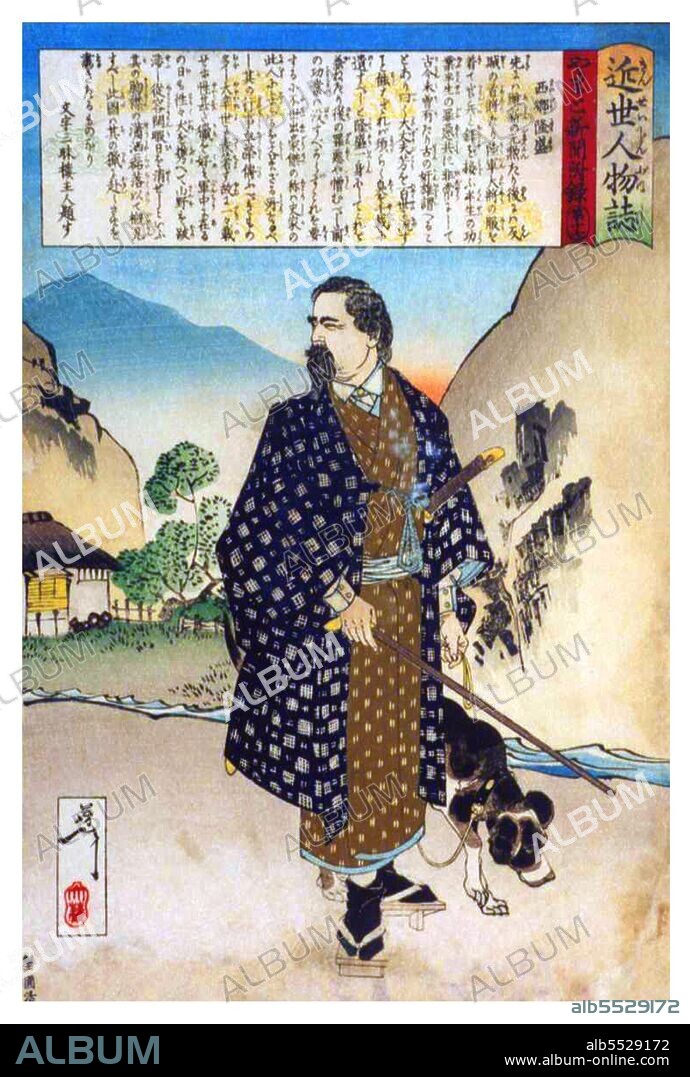alb5529172
Japan: The 'Last Samurai' Saigo Takamori (1828-1877) walking a dog. Tsukioka Yoshitishi (1839-1892)

|
Add to another lightbox |
|
Add to another lightbox |



Title:
Japan: The 'Last Samurai' Saigo Takamori (1828-1877) walking a dog. Tsukioka Yoshitishi (1839-1892)
Caption:
Saigo Takamori, original name Kichibe or Kichinosuke, literary name Nanshu, was one of the most influential samurai in Japanese history. He lived during the late Edo Period and early Meiji Era, and became a leader of the Meiji restoration. In 1867, Saigo’s troops supported the Emperor in the Meiji Restoration; with Katsu Kaishu, who was the representative of the Shogunate government, he achieved the bloodless surrender of Edo Castle and successfully conducted the coup d’etat of 'Osei Fukko' (Restoration of Imperial rule). He was later put in command of over 50,000 samurai, a large segment of the Imperial army. As a 'Sangi' (councillor) in the new government, he helped to push through reforms. His participation in the restoration made him a legendary hero, but the same reforms dissolved the samurai system and caused him to lose his status. In 1873, he resigned his government post after losing in the 'Seikanron' (Debate over conquering Korea). In 1877, with the encouragement of the students of his private school in Kyushu, Saigo organized the Satsuma Rebellion against the government he had helped to restore. He was defeated by the government army and committed suicide. He later became a symbol of devotion to principle.
Credit:
Album / Pictures From History/Universal Images Group
Releases:
Model: No - Property: No
Rights questions?
Rights questions?
Image size:
3353 x 4973 px | 47.7 MB
Print size:
28.4 x 42.1 cm | 11.2 x 16.6 in (300 dpi)
Keywords:
ARMS: SAMURAI SWORD • ART • ARTS • ASIA IMAGE • ASIA IMAGES • ASIA PICTURES • ASIA • ASIAN IMAGE • ASIAN IMAGES • ASIAN PICTURES • ASIAN • BUSHIDO • CASTA • CASTE • HISTORIA UNIVERSAL • HISTORICAL IMAGES • HISTORICAL PICTURES • HISTORICAL • HISTORY IMAGES • HISTORY PICTURES • HISTORY • JAPAN • JAPAN: SAMURAI • JAPANESE • LAST SAMURAI • LEGEND • MILITAR • MILITARS • MILITARY • PAINT • PAINTING • SAIGO TAKAMORI • SAMURAI SWORD • SAMURAI WARRIOR • SAMURAI • SOLDIER • TOKUGAWA • TROOPS • TSUKIOKA YOSHITOSHI • UKIYO-E • WARRIOR • WARRIORS • WAY OF THE WARRIOR • WOODBLOCK • WOODCUT • XYLOGRAPHY
 Pinterest
Pinterest Twitter
Twitter Facebook
Facebook Copy link
Copy link Email
Email
